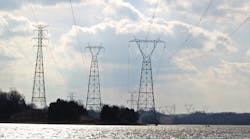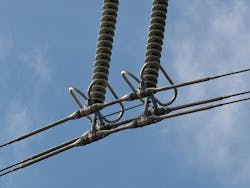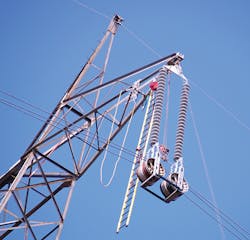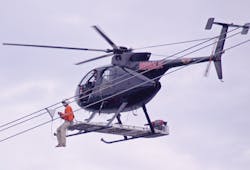TVA Pushes More Power Down the Corridor
The Tennessee Valley Authority (TVA) is no stranger to 500-kV transmission lines or the relentless need to modify existing power lines to meet the energy demands of the region. But, when the utility needed to increase the ampacity rating of its 500-kV Pin Hook-Wilson transmission line to meet load growth, the engineering department was forced to think outside the box.
To achieve the increased capacity, design engineers at TVA needed to increase the maximum operating temperature of the conductors to 100°C (212°F). Increasing the operating temperature of the line made the existing conductors sag lower and created clearance violations that usually would be handled by increasing the conductor attachment height, lowering distribution crossings or modifying conductor tensions.
A 1-mile (1.6-km) section of the line crossed over John Percy Priest Lake and Long Hunter State Park. The U.S. Army Corps of Engineers (USACE) controls the lake, and the Tennessee State Park Service maintains the surrounding property. The lower sag from the uprate project on the 2,530-ft (771-m) span over the lake violated a 1970 USACE permit by 4 ft (1.2 m). However, when TVA contacted the USACE to modify the existing permit, the updated permit was issued with a minimum conductor elevation that was 14 ft (4.3 m) higher than the original permit. This created an 18-ft (5.5-m) clearance violation over the lake.
Existing Conditions
The existing 500-kV transmission line was a three-bundle-per-phase 954,000-cmil 54/7 aluminum conductor steel reinforced (ACSR) conductor supported by two 250-ft (76-m)-tall lattice suspension towers and two 170-ft (52-m)-tall dead-end lattice towers. Depending on lake levels, all or part of the suspension tower foundations are located inside the lake. Environmental concerns over Osprey and Indiana bats, as well as special clearing agreements with the state park, complicated the construction efforts and threatened to delay the project.
Although both of the suspension towers are more than 200 ft (61 m) tall and normally would require aeronautical lighting and marking, the utility was able to avoid the aeronautical requirements because taller towers on adjacent lines had aeronautical lighting and marking.
Evaluating Options
TVA evaluated several options to meet the new permit height requirements, including tower modifications, installing new towers, retensioning the existing conductor and installing new conductor.
The tower modification option would add a 20-ft (6.1-m) lattice extension to the existing 250-ft (76-m)-tall towers. Since this would make the towers taller than the adjacent lines, this option also would require both suspension towers be equipped with aeronautical warning lights, solar panels, batteries, monitoring systems and hazard spheres, and the towers would need to be painted with aviation orange and white paint. Installing the extensions would require a 300-ft (91-m)-tall crane to be located on barges inside the lake. The crane would have to be trucked in and assembled on site.
The option of designing and constructing a new river crossing tower that would be located near one of the existing towers had complications, too. The new tower would be 300-ft tall and require a taller crane. New foundations would need to be constructed in the lake. The same aeronautical marking modifications as the previous option would be needed. Then the old tower would need to be removed. Environmental permitting for installing foundations inside the lake also was evaluated as part of this option.
Another option, retensioning the existing conductor, was analyzed, but the tension required to achieve the needed clearance far exceeded the National Electrical Safety Code allowable tensions for the existing conductors. The additional tension also would have overloaded the dead-end structures, requiring modifications to those structures and possibly their foundations.
For the reconductor option, all ACSR wires failed to provide the required clearance and ampacity, and required major modifications to the structures. Use of a conductor option with annealed aluminum was found to meet the sag and ampacity requirements, but this option was eliminated because of the risk of corona damage on this 500-kV application.
Although TVA had never used aluminum conductor composite reinforced (ACCR) on its transmission system, TVA engineers explored ACCR as an option. An 824,000-cmil 24/19 ACCR operating at 112°C (234°F) was found to meet the minimum sag and ampacity requirements. It could be installed at a lower tension than the existing conductor. Smaller ACCR conductors operating at elevated temperatures would have to meet the ampacity requirements, but corona concerns dictated the conductor diameter be 1 inch (25 mm) or larger.
Determining a Solution
After evaluating all of the options, TVA determined the ACCR reconductor would be the least costly as well as the option with the lowest environmental impact. ACCR is normally used on lines that have high operating temperatures to take advantage of the lower thermal expansion rate of the ACCR core wire, but, for this project, the main advantage for TVA was the difference in the weight of the conductor. The 824,000-cmil 24/19 ACCR was 36% lighter than the existing 954,000-cmil 54/7 ACSR, allowing the ACCR to be installed at 500 lb (227 kg) less tension than the previous conductor while sagging 24 ft (7.3 m) less.
When TVA contacted the manufacturer about the possibility of using its ACCR conductor on this project, TVA discovered ACCR had been used in a twin bundle at 400 kV in Europe, but it had never been used at 500 kV, and it had never been used in a three-conductor bundle. Although the manufacturer was excited about TVA using ACCR in an application in which it had never been used, it was also challenged by the new technical aspects of a 500-kV three-bundle installation.
Working Through Challenges
When TVA sent the purchase order to the ACCR manufacturer in the fall of 2011, the manufacturer informed the utility that, because of high demand, the lead time for an ACCR conductor would be two years. The two-year lead time on the ACCR conductor pushed out the in-service date for the project by one year. However, the manufacturer started a second production line in 2012, and the lead times today for ACCR vary from three to four months.
Based on the installation guidelines for ACCR and the manufacturer technical team’s advice, the allowable bend angle of the conductor during construction and at suspension clamps had to be kept to a minimum. The utility worked with industry experts to design a double-string suspension assembly for a 500-kV three-bundle conductor. The new suspension assembly also would be required to accommodate Thermolign-type suspension.
Special tandem stringing blocks were built to minimize the bend angle while the conductor was being installed. The stringing block frames were designed to match the spacing of the insulators and had to accommodate the T-plates used in the suspension assembly.
The U.S. government shutdown that lasted from Oct. 1 to Oct. 16, 2013, also threatened to delay the project. A request to clear less than 1 acre (0.4 hectare) had been submitted to the U.S. Fish & Wildlife Service before the shutdown and the concurrence to clear was issued only two days before construction began.
The ACCR manufacturer provided a construction representative before the project began to ensure the TVA construction crew was properly trained on how to handle the ACCR conductor. The representative also remained on-site during the first week of construction to ensure the first phase was installed correctly.
TVA contracted with helicopter crews to remove the spacer dampers in the existing line and reinstall new spacer dampers after the ACCR conductor was installed. The helicopters also assisted TVA construction crews by transporting ladders and rigging material up to the towers.
TVA also had to ensure the safety of boaters while the conductors were being pulled across the lake. Detailed stringing plans were developed to maintain acceptable clearances over the water during construction and to ensure a safe installation for the public and crew. TVA also placed warning buoys on the upstream and downstream sides of the work area, and 10 TVA boats were stationed in strategic areas to warn boaters of the overhead line work. TVA helicopters also patrolled the area during stringing operations and maintained radio communication with the safety boats to alert them of any other boats headed toward the work area at high speed.
Energized
TVA energized the world’s first 500-kV transmission line on May 15, 1965. In that same spirit of innovation, the utility completed and energized the world’s first 500-kV transmission line using an ACCR conductor and the first three-bundle ACCR configuration on Dec. 4, 2013. By choosing the ACCR option, TVA minimized adverse impacts to the environment, saved considerable expense relative to the other options and continued TVA’s efforts to provide low-cost, reliable power to the ratepayers of Tennessee.
Jeffery L. Phillips ([email protected]) is a senior engineer in the transmission line design group at the Tennessee Valley Authority. He graduated from the University of Tennessee with a BSCE degree and has an associate’s degree in mechanical engineering. Phillips is a registered professional engineer in the state of Tennessee and has been with TVA for 12 years. He is currently responsible for designing transmission lines and oversees the design, installation and maintenance of all transmission line switches.
Companies mentioned:
Tennessee Valley Authority | www.tva.gov






